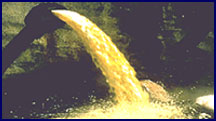 The
detection and elimination of pollutants being discharged into the MS4. Primarily, any discharge into the MS4 other than stormwater runoff including direct connections of waste water and effluent from residential or industrial/commercial sources. Municipalities must map all outfalls into surface water bodies, outfalls into adjacent MS4s and all infiltration practices such as dry-wells. Additionally, Municipalities must adopt a local law prohibiting illegal connection to or illegal dumping into the MS4. Lastly, Municipalities must regularly monitor outfalls to maintain water quality. Examples of prohibited practices include wastewater/grey water or rooftop runoff conveyances connected to the MS4 and disposal of chemicals and other waste products into ditches, storm sewers, catch basins, etc. The
detection and elimination of pollutants being discharged into the MS4. Primarily, any discharge into the MS4 other than stormwater runoff including direct connections of waste water and effluent from residential or industrial/commercial sources. Municipalities must map all outfalls into surface water bodies, outfalls into adjacent MS4s and all infiltration practices such as dry-wells. Additionally, Municipalities must adopt a local law prohibiting illegal connection to or illegal dumping into the MS4. Lastly, Municipalities must regularly monitor outfalls to maintain water quality. Examples of prohibited practices include wastewater/grey water or rooftop runoff conveyances connected to the MS4 and disposal of chemicals and other waste products into ditches, storm sewers, catch basins, etc.
Ways to help:
- Reducing Your Domestic Footprint:
Common sources of residential stormwater pollution include fertilizers from landscaping, water from impervious surfaces such as roofs and driveways, household waste, and sediment from construction. In some cases, you may be able to get support for some of these initiatives from your local government. Contact your municipality to learn more about the programs such as Spring Clean-up, Household Hazardous Waste Collection, Mulch and Composting Organic Waste and Street-sweeping.
Improving Yard Management:
There are a variety of ways you can reduce your stormwater impact through improved yard landscaping. Many of these are simple, including reducing fertilizer use and mowing the lawn higher. Additionally, consider replacing standard turf grass with alternatives such as native perennials and groundcovers.
Proper Disposing of Household Waste
Collecting Rainwater:
Owners of existing homes can “retro-fit” their residences by installing rain barrels to help reduce runoff from their lot. Contact Blue Neils at (518)-885-8995 or brn5@cornell.edu for instruction and installation.
Buying a new Home:
New-home buyers should consider the design of their home and the development that surrounds it. Residents, as consumers, have the right to insist on better Stormwater Management Practices to be installed on their own home-site. You can also be a more discerning consumer by purchasing homes in developments that utilize Low-Impact Development (LID) or other modern practices to manage runoff.
|